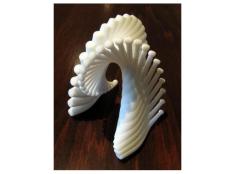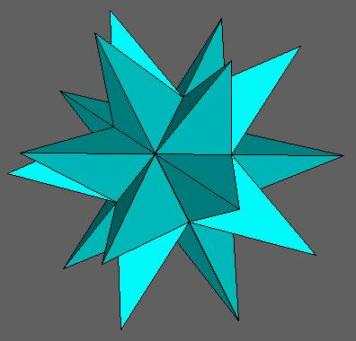Welcome to this week’s Math Munch!
It’s my turn now to post about how much fun we had at Bridges! One of the best parts of Bridges was seeing the art on display, both in the galleries and in the lobby where people were displaying and selling their works of art. We spent a lot of time oogling over the 3D printed sculptures of Henry Segerman. Henry is a research fellow at the University of Melbourne, in Australia, studying 3-dimensional geometry and topology. The sculptures that he makes show how beautiful geometry and topology can be.
 These are the sculptures that Henry had on display in the gallery at Bridges. They won Best Use of Mathematics! These are models of something called 4-dimensional regular polytopes. A polytope is a geometric object with flat sides – like a polygon in two dimensions or a polyhedron in three dimensions. 4-dimensional polyhedra? How can we see these in three dimensions? The process Henry used to make something 4-dimensional at least somewhat see-able in three dimensions is called a stereographic projection. Mapmakers use stereographic projections to show the surface of the Earth – which is a 3-dimensional object – on a flat sheet of paper – which is a 2-dimensional object.
These are the sculptures that Henry had on display in the gallery at Bridges. They won Best Use of Mathematics! These are models of something called 4-dimensional regular polytopes. A polytope is a geometric object with flat sides – like a polygon in two dimensions or a polyhedron in three dimensions. 4-dimensional polyhedra? How can we see these in three dimensions? The process Henry used to make something 4-dimensional at least somewhat see-able in three dimensions is called a stereographic projection. Mapmakers use stereographic projections to show the surface of the Earth – which is a 3-dimensional object – on a flat sheet of paper – which is a 2-dimensional object.
To do a stereographic projection, you first set the sphere on the piece of paper, or plane. It’ll touch the plane in exactly 1 point (and will probably roll around, but let’s pretend it doesn’t). Next, you draw a straight line starting at the point at the top of the sphere, directly opposite the point set on the plane, going through another point on the sphere, and mark where that line hits the plane. If you do that for every point on the sphere, you get a flat picture of the surface of the sphere. The point where the sphere was set on the plane is drawn exactly where it was set – or is fixed, as mathematicians say. The point at the top of the sphere… well, it doesn’t really have a spot on the map. Mathematicians say that this point went to infinity. Exciting!
A stereographic projection like this draws a 3-dimensional object in 2-dimensions. The stereographic projection that Henry did shows a 4-dimensional object in 3-dimensions. Henry first drew, or projected, the vertices of his 4-dimensional polytope onto a 4-dimensional sphere – or hypersphere. Then he used a stereographic projection to make a 3D model of the polytope – and printed it out! How beautiful!
 |
 |
 |
Here are some more images of Henry’s 3D printed sculptures. We particularly love the juggling one.
Henry will be dropping by to answer your questions! So if you have a question for him about his sculptures, the math he does, or something else, then leave it for him in the comments.
Speaking of polyhedra, check out this site of applets for visualizing polyhedra. You can look at, spin, and get stats on all kinds of polyhedra – from the regular old cube to the majestic great stellated dodecahedron to the mindbogglingly complex uniform great rhombicosidodecahedron. You can also practice your skills with Greek prefixes and suffixes.
 |
 |
 |
Finally, two Math Munches ago, we told you about some videos made by the mathematical artist George Hart. He’s the man who brought us the Yoshimoto cube. And now he’s brought us… Pentadigitation. In this video, George connects stars, knots, and rubber bands. Enjoy watching – and trying the tricks!
Bon appetit!

Pingback: Pretty! « Take It To The Limit
Hi !
The image of the stereographic projection of the earth is taken from the excellent french film “Dimensions”. You will find it here : http://www.dimensions-math.org/ (there is an english translation).
Keep up the good work !
Thanks, dude! We actually mentioned the dimensions series a post called Numberphile, Cube Snakes, and The Hypercube, but it was just a link. Almost an afterthought. Maybe it deserves to be featured more prominently in a new post. Stay tuned. 🙂
Thanks for commenting.
Ahah ! I didn’t want to make a fool of myself so before posting the comment I searched for “dimensions” in the search bar and, well, it seems that I overlooked this result 😉
As usual, thanks a lot and keep up the good work !
Wow! That is very cool and how could the side of the points be on the top or bottom? Well I may have to try this out myself! Seems fun! I’ll have to find the answer to my own problem!
That is a very interesting puzzle, I wonder how many more combinations can be found if possible?
Pingback: Math Meets Art, Quarto, and Snow! | Math Munch
The pentadigitation video was really cool! I had no idea there were so many different combinations to make a star with your fingers. What other pentagonal shapes can you make with your hands?
I never knew that you could actually make these connections between astronomy and ruber bands. I always knew how to make a tea cup or the Eiffel Tower with a rubber band but not all the star shapes and formations.
Hi, Kenya! Yeah– I always knew those string games with the tea cup and Eiffel Tower, too, but the stars are really awesome. I’m glad you enjoyed!
I enjoyed watching George Hart make shapes and stars out of rubber bands. I like the way he was straight to the point in his video so the timing wasn’t that long. I even tried making my own star with a rubber band.
I thought it was awesome to watch George Hart create stars with rubber bands. The only thing i could ever make was a circle LOL. But i found it interesting that someone science can be connected to something so small as a rubber band.
It’s amazing how you managed to make shapes out of rubber bands. What are the thirty two ways to put it together? Did you try all of those ways before coming to a solution?
oh my god that was really really cool and neat
Is it possible for you to make any other shapes? Also is there ever an ecxact number of rubber bands you would need for the more difficult shapes? – Ty’ana Hooks
I think that George Hart did a great job of explaining. It was very interesting how he was able to create a star out of a rubber band. I also loved how all of it was linked to science. I wounder how many other pentagons could be made out of rubber bands in one’s hand?
George Hart’s video was really interesting. He step by step demonstrated how to make a star, with one hand, out of a rubber band. The way he explained how, really made me want to try this. I wonder if it’s possible to make other shapes out of one rubber band in one hand?
George Hart;s video was very explanatory and entertaining. In order to have the practice of creating a star with one hand is pretty impressive. Science is crazy to understand just like this. I was pretty amazed how he had the patience and time to explain something he had mastered at.
The pentadigitation is really interesting and I tried it out! It’s fun to figure out how it works.
The star made out of a rubber band amazed me. I really want to try to make it and even make more shapes out of rubber bands!